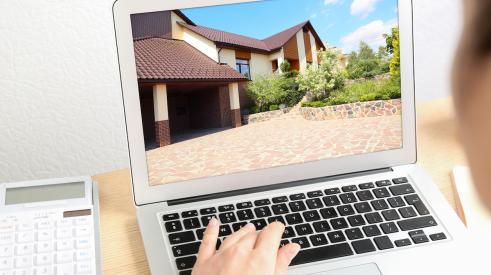The tablet PC has become a powerful business tool for home builders, architects, and designers alike. The iPad, Motorola Xoom, Samsung Galaxy, and other tablets are widely used for such applications as construction management, sales tracking, and customer service.
In residential design, though, the use of tablets has primarily been limited to client presentations and annotating drawings on the job site. Wheaton, Ill.-based architect Christopher Derrick recognized the potential of the iPad after giving his wife one for Christmas. “I played around with it longer than she did, so I decided to get one for myself,” he says.
Derrick uses his iPad primarily for client presentations. “Instead of carrying a large portfolio with drawings, I put together a portfolio on the iPad, which is very easy to do,” he says. “Instead of having to print out and enlarge photos, I can upload them to the iPad as soon as I take them with a digital camera, so the portfolio is up to date.” Presentations can be modified to show only new construction or only remodeling projects, depending on the client. Derrick also has an overview presentation that mixes the two.
5 ways builders, architects, and designers are using tablets to design homes
1. Client presentations — Architects and designers can quickly update, access, and present their entire portfolio of work with the tap of a finger.
2. Annotating drawings — Using apps like AutoCAD WS, design professionals can instantly access, change, and markup CAD drawings while on the jobsite or the road.
3. Create an online library of colors, textures, and materials — There are a host of apps for evaluating material and color choices. Virtual design boards can be loaded with fabric swatches, tiles, and other samples, and several major paint suppliers now offer tablet apps for color matching.
4. Basic design from scratch — Tools like SketchBook Pro allow designers to create drawings from scratch with a tablet, using either a stylus or finger touch. Think of it as a replacement to the napkin sketch.
5. Virtual design meetings — Virtual face-to-face meetings allow design team members and clients in multiple locations to collaborate on projects using CAD drawings, PDFs, screen captures, emails, and other key documentation.
“I mainly use AutoCAD for architectural drawings, plus some minor programs that are more structural,” he says. “I’ll also take PDFs of different projects, load them onto the iPad, and go off to the job site. I have all the details with me; I’m not trying to page through everything or hold up a 24-by-36-inch drawing. It’s all on my screen.”
At press time, Derrick had just purchased AutoCAD WS, a mobile application that will automatically sync plan changes made on the iPad with his office computer, and allow him to access, edit, and share drawings with clients and builders.
Tal Weiss, lead developer of AutoCAD WS, says the app is now also compatible with Android phones and tablets. Architects, engineers, and builders are the dominant users, says Weiss.
The untapped potential of tablets
Versatile as they are, tablets are not ideal for full-blown design applications — yet.
“The challenge with design on the iPad is that you’re doing everything with your fingers, so it’s not as precise,” says Derrick. “If there was some way to hook up a mouse to it, I think it would be very functional, but until it gets to that point, tablets are going to be much more useful for presentation and viewing and office work.”
Mark Johnson, director of architect relations and education for Masco Cabinetry, Taylor, Mich., agrees: “Based on the apps that have been developed, the tablet is more of a presentation tool than an actual design tool. You can do some notation and light drafting, but not heavy design work.”
However, Johnson is digging deeper into the potential of tablets for home design. He recently created a presentation that showcases business applications for the iPad that Masco can use in its kitchen and bath showroom, as well as in the field. Johnson’s portfolio of 16 apps includes a virtual design board with fabric swatches, tiles, and other samples; a paint color-matching app; and a gallery of kitchen and bath photos that helps clients jump-start their projects.
Masco already uses Google SketchUp, a 3D CAD program, to design cabinetry. There is currently no iPad app for SketchUp, but Johnson found a reader called 3-D Dea for viewing SketchUp files on the iPad.
“We thought that with better project organization, communication, online sharing, and 3D visualization, the iPad would be a powerful tool for helping them sell projects,” he says. “I’ll sometimes hear folks say that with all these new tools they’re using, they’re able to sell kitchens faster. You can take a design you’re working on and show it to customers on an iPad in 3D. It’s in full color, and you can pan around it and take them on a walkthrough of what hopefully will become their future kitchen or bath.”
Like Derrick, Brian McMillen of McMillen Designs in Wasilla, Alaska, uses his iPad more frequently for client presentations than anything else. Occasionally, McMillen makes design changes in the field at a client’s request, and he expects to be doing more of that in the future. He says a tablet with a 3D viewer would be useful: “I’m taking Revit files and Architectural Desktop files that are 3D and basically using them in 2D.”
Tablet Report Contents
Exclusive Research
Tablets on the Jobsite
Designing with Tablets
Using Tablets to Market and Sell Homes
Product Review: Which Tablet is Right for You?
99 Tablet Apps Made for Builders
Joel Esposito, a 3D artist who produces digital marketing materials for True Design Studio in Jacksonville, Fla., loads collateral onto an iPad for viewing in 2D and 3D — sort of. “The 3D content consists of interactive panoramas,” says Esposito. “Although it’s not true 3D, it really does look and feel like it.”
For now, McMillen is happy that he doesn’t have to tote rolled-up blueprints to construction sites with a scale to make sure the dimensions are accurate. “Being able to check the actual drawn dimensions and scaling it off the drawings is not necessarily a time saver, but it eliminates the margin for error.”
Luck of the draw
SketchBook Pro (another Autodesk product) is, as the name suggests, a digital sketchbook, though unlike SketchUp, it’s a 2D program. Chris Cheung, SketchBook product line manager, says professional designers as well as hobbyists and artists use the program. SketchBook Pro for iPad was launched in April 2010, and a version for Android was released in July 2011. Users sketch directly on the tablet’s touch-sensitive screen either with their finger or a stylus. There are different levels of sophistication; for example, the premium edition of SketchBook Pro allows designers to work with multiple layers of a sketch.
Cheung says designers who spend a lot of time on the road are using SketchBook Pro for iPad as “a kind of whiteboard with their office.” The office team emails the designer layouts, screen captures, or digital photos, “then the designer fires up SketchBook and annotates them or does a design concept over them, makes some adjustments, and sends the email back to the office.”
True Design Studio is using AutoCAD WS and will soon implement other Autodesk and Adobe applications such as SketchBook Pro. Esposito believes that when accompanied with a stylus, SketchBook Pro will prove to be the most versatile. “It will do away with the napkin sketch and allow us to develop concepts on the fly,” he says. “It may prove to be particularly powerful since you could feasibly take a picture with your iPad 2 camera, then draw over it in SketchBook.”
Esposito adds that this capability “could be a real game changer for remodeling projects. Someone in the field could sketch in a client’s requests, send it back to the studio to get feedback, and within minutes we could have a mature concept ready to be reviewed.”
Does tablet screen size matter?
One builder who was using tablets on a day-to-day basis abandoned them in favor of the smart phone. “Primarily I was using a tablet for my own organization, because I had so much to keep track of,” says Ron Paulk of Paulk Custom Homes, Anacortes, Wash. He now performs the same functions on an iPhone, which fits in his pocket and has a construction calculator, camera, and voice recorder, in addition to Internet connectivity and email.
From a design standpoint, though, Derrick prefers the tablet. He tried putting PDFs on his phone and found that the screen was too small. “Even though you can enlarge images on a phone, you have a much larger viewing area on an iPad,” he says. “I think that’s completely worth it.”
Johnson says the tablet doesn’t lend itself to the way most professionals work with CAD applications. “They use a mouse with a scroll wheel, which is a big time saver in SketchUp,” he says. Johnson uses a 24-inch monitor connected to his laptop when he’s drawing “because everything is so easy to see. Right now, the process that a lot of us are used to might feel a bit clunky on a tablet.”
Still, don’t underestimate the speed of technological advancement. By this time next year, there could be an app or device that facilitates full-scale home design on a tablet.
Advertisement
Related Stories
Products
Boost Jobsite Productivity With These 6 New Construction Products
Construction tools to reduce manual labor, save time, and boost your efficiency on the jobsite
Innovation
3 Home Building Innovations You Have to See
Efficient tools for the jobsite, sales center, and inspections—a Horizon TV classic
Sales + Marketing
Real Estate's New Normal: Virtual Selling Tools
Both homebuyers and sellers benefit from virtual selling tools: one side can view listings faster and easier while the other gains more attention…








